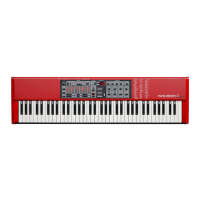About the MIDI implementation
The following MIDI messages can be transmitted and received from the
Nord Electro 3:
Note On/Off
Note On and Note Off messages are transmitted and received.•
Controllers
In the MIDI Menu (see page 18), you can select if the Nord Electro 3
should transmit and/or receive Control Change messages.
Incoming MIDI Controller 7 controls the overall volume of the Electro 3.•
Incoming MIDI Controller 10 controls the panning of the Electro 3. •
If you have a control pedal connected to the control pedal input, this •
is transmitted as Controller 11 (Expression).
If you have a pedal connected to the sustain pedal input, this is •
transmitted as Controller 64 (Sustain Pedal).
If you have a pedal connected to the rotor pedal input, this pedal is •
transmitted as Controller 90.
Almost all other controls (knobs and buttons) on the front panel are •
also transmitted (and received) as Control Change messages. This
can be used to record your actions on the front panel into a MIDI
sequencer. For a full list of which parameters correspond to the Con-
troller numbers, see the MIDI implementation on the next page.
Keyboard velocity
The Nord Electro 3 can transmit and receive keyboard velocity mes-
sages. Organ sounds will always be played back at nominal level
regardless of incoming MIDI Velocity data. Release velocity is also
transmitted.
Program change
In the MIDI Menu (see page 18), you can select if the Nord Electro 3
should send and/or receive Program Change messages.
When you select a Program, a Program Change message is transmit-
ted via MIDI. If a Program Change message is received on the selected
MIDI Channel, the Nord Electro 3 will change Program accordingly.
The 128 Program locations send and respond to MIDI Program
Change values 0-127.
MIDI Sysex (System Exclusive)
Individual Programs or all Programs can be transmitted and received as
a System Exclusive dump.
Using the Nord Electro 3 with a
sequencer
Connections
Connect the MIDI Out on the Nord Electro 3 to the MIDI In on your 1
sequencer.
Connect the MIDI Out from your sequencer to the MIDI In on the 2
Nord Electro 3.
Local On/Off
Local Off may be used when you use a sequencer to record and play
back from Nord Electro 3. If the sequencer echoes back incoming
MIDI data, the Nord Electro 3 may respond twice to every note and
other message/action if e.g. the keyboard and the sequencer sends
the same MIDI information to the unit. Local On/Off is set on the “MIDI
menu” see page 18.
MIDI Channel
The MIDI channel(s) that the Nord Electro 3 uses are set up in the MIDI
menu - see “MIDI menu” on page 18. If you use the Organ model in
the split/lower manual configuration, the lower manual can receive on a
separate MIDI channel.
Program Change
Usually you select a Program Change value for a track in the sequenc-
er track settings. The 128 program locations send and respond to
Program Change values 0-127.
If you want to record a Program Change message, activate recording in
the sequencer and simply select the program on the Nord Electro 3.
Controllers
When you record actions with knobs and buttons, make sure that the
sequencer “echoes” the changes back on the correct MIDI Channel, or
your changes won’t have any effect.
Some notes about controllers and “chasing”
Consider a situation where you record a Controller message, e.g. a
Drawbar opening, in the middle of your sequencer song. Then you
“rewind” the sequencer to a position before the recorded Drawbar
opening. The problem is that the Nord Electro 3’s Drawbar will remain
opened, although it really should be as it was before you recorded the
opening.
To solve this, you could record a “snapshot” of all Controller settings of
the Nord Electro 3 Program at the beginning of your sequencer song.
See “Sending MIDI Controller dumps” below.
9
MIDI functions

